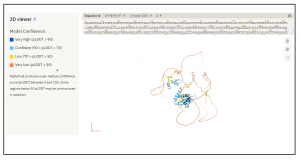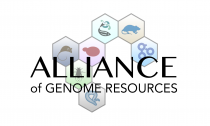Difference between revisions of "SGD Newsletter, Fall 2021"
(→AlphaFold Predicts 3D Protein Structure) |
(→Upcoming Publication in Genetics Issue XX) |
||
| Line 98: | Line 98: | ||
*Subsets analysis | *Subsets analysis | ||
| − | ==Upcoming Publication in Genetics Issue XX== | + | ==Upcoming Publication in Genetics Issue XX - ''maybe can leave out since we have enough items?''== |
*GENOME VERSION R64.3.1 | *GENOME VERSION R64.3.1 | ||
| Line 104: | Line 104: | ||
*HOMOLOGY AND THE ALLIANCE OF GENOME RESOURCES | *HOMOLOGY AND THE ALLIANCE OF GENOME RESOURCES | ||
*OTHER UPDATES | *OTHER UPDATES | ||
| − | |||
==Happy Holidays from SGD!== | ==Happy Holidays from SGD!== | ||
Revision as of 13:30, 4 November 2021
About this newsletter:
This is the Fall 2021 issue of the SGD newsletter. The goal of this newsletter is to inform our users about new features in SGD and to foster communication within the yeast community. You can view this newsletter as well as previous newsletters on our Community Wiki.
Contents
- 1 Nomenclature Updates
- 2 New links to AlphaFold 3D Predicted Protein Structure Database
- 3 YeastMine Updates
- 4 Alliance of Genome Resources at [Version 4.1]
- 5 Upcoming Conferences
- 6 Gene Ontology Consortium Fall Meeting
- 7 Upcoming Publication in Genetics Issue XX - maybe can leave out since we have enough items?
- 8 Happy Holidays from SGD!
Nomenclature Updates
Legacy gene names
SGD has long been the keeper of the official Saccharomyces cerevisiae gene nomenclature. Robert Mortimer handed over this responsibility to SGD in 1993 after maintaining the yeast genetic map and gene nomenclature for 30 years.
The accepted format for gene names in S. cerevisiae comprises three uppercase letters followed by a number. The letters typically signify a phrase (referred to as the "Name Description" in SGD) that provides information about a function, mutant phenotype, or process related to that gene, for example "ADE" for "ADEnine biosynthesis" or "CDC" for "Cell Division Cycle". Gene names for many types of chromosomal features follow this basic format regardless of the type of feature named, whether an ORF, a tRNA, another type of non-coding RNA, an ARS, or a genetic locus. Some S. cerevisiae gene names that pre-date the current nomenclature standards do not conform to this format, such as MRLP38, RPL1A, and OM45.
A few historical gene names predate both the nomenclature standards and the database, and were less computer-friendly than more recent gene names, due to the presence of punctuation. SGD recently updated these gene names to be consistent with current standards and to be more software-friendly by removing punctuation.
| ORF | Old gene name | New gene name |
|---|---|---|
| YGL234W | ADE5,7 | ADE57 |
| YER069W | ARG5,6 | ARG56 |
| YBR298C | DUR1,2 | DUR12 |
| YIL154C | IMP2' | IMP2 |
New Systematic Nomenclature for yeast genes not in the reference genome
New links to AlphaFold 3D Predicted Protein Structure Database
https://alphafold.ebi.ac.uk/about
- With a cutting-edge AI system, EMBL’s European Bioinformatics Institute (EMBL-EBI) offers a new, highly accurate tool for predicting protein structure with speed and clarity.
- Given a peptide sequence for an uncharacterized protein, AlphaFold will model predicted domains and provide relative confidence levels for each portion of the prediction.
- The predicted domains can then be compared to known protein structures (using a tool such as PDBeFold, https://www.ebi.ac.uk/msd-srv/ssm/) to seek matches to characterized protein families.
- Whether or not a family is identified, the comparison will yield clues to protein function to help design the next experiments.
YeastMine Updates
SGD has updated YeastMine with ...
Alliance of Genome Resources at [Version 4.1]
The Alliance of Genome Resources, a collaborative effort from SGD and other model organism databases (MOD), released version 4.1 in August. Notable improvements and new features include:
- Added Human and model organism high throughput (HTP) variant data.
- Human variants are imported from Ensembl.
- Model organism HTP variants are submitted by Alliance members (FlyBase, RGD, SGD, Wormbase) or imported from EVA (mouse and zebrafish).
- Added HTP variants to the Alleles and Variants table on gene pages (e.g. rat Lepr Gene page) and to the table on the Alleles and Variants Details page (e.g. rat Lepr Alleles and Variants Details.
- Created a report page for Human and model organism HTP variants (e.g. human variant rs1041354454).
- Expanded Allele Category in search to “Allele/Variant” and added a search for HTP variants.
- HTP variants are currently only displayed for variants within a gene. Intergenic variants will be available in a future release.
- On Gene Pages, a new Pathways widget displays via tabs:
- Reactome models of pathways for human gene products as well as inferred pathways for model organism genes based on orthology to human genes.
- Reactome reactions for gene products (e.g. human TP53 Gene page)
- Gene Ontology Causal Activity Models (GO-CAMs). These provide a framework to represent a biological system by linking together multiple GO annotations. PMID:31548717 (e.g. worm nsy-1 Gene page).
Experimental conditions are include for Disease and Phenotype data in tables on Gene, Allele, and Disease pages (e.g. zebrafish scn1lab Gene page).
- AllianceMine added Orthologs, and Allele and Variants (low throughput) data types to this release. You can now query for these data types via pre-made template queries.
- The Alliance Community Forum is released. The Forum permits discussions across six model organism communities—flies, mice, yeast, rats, worms, and zebrafish. More details will follow.
Upcoming Conferences
- Fungal Genetics
- 36th International Specialised Symposium on Yeasts (ISSY36)
- Yeast Genetics
Gene Ontology Consortium Fall Meeting
Held virtually October 12 to October 14, with participants from XX countries. Featuring presentations on:
- Internal updates from the Gene Ontology Consortium
- Gene Alliance Pathway Viewer
- Metrics analysis
- LitSuggest
- ECO, Evidence and Conclusions Ontology
- Reactome
- RNA Central
- PAINT
- Harmonizing Regulates closure over the various GOC products
- Complex Portal New annotation
- JaponicusDB
- ChEBI
- UniProt: Plan for pathway curation
- Subsets analysis
Upcoming Publication in Genetics Issue XX - maybe can leave out since we have enough items?
- GENOME VERSION R64.3.1
- ALLELES
- HOMOLOGY AND THE ALLIANCE OF GENOME RESOURCES
- OTHER UPDATES
Happy Holidays from SGD!
We know that 2021 has been another challenging year for everyone. Our thoughts go out to all those who have been impacted by recent events. We wish you and your family, friends, and lab mates the best during the upcoming holidays.
Stanford University will be closed for two weeks starting on December 20 and will reopen on January 3rd, 2022. Although SGD staff members will be taking time off, the website will be up and running throughout the winter break, and we will resume responding to user requests and questions in the new year.


